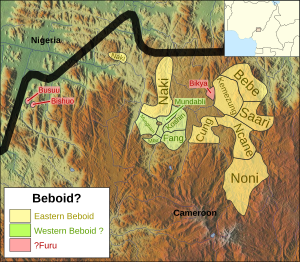Western Beboid
| Beboid | |
|---|---|
| Geographic distribution |
Southwest Cameroon, southeast Nigeria |
| Linguistic classification |
Niger–Congo
|
| Subdivisions |
|
| Glottolog |
None east2730 (Eastern Beboid) |

The Beboid languages shown in western Cameroon and eastern Nigeria
|
|
The Beboid languages constitute a branch, or branches, of Southern Bantoid and are spoken principally in southwest Cameroon, although two languages (Bukwen and Mashi) are spoken over the border in Nigeria. The Eastern Beboid languages may be most closely related to the Tivoid and Momo groups, though Western Beboid, if it's a group at all, may be closer to Ekoid and Bantu.
Previous research includes a study of noun classes in Beboid languages by Jean-Marie Hombert (1980), Larry Hyman (1980, 1981), a dissertation by Richards (1991) concerning the phonology of three eastern Beboid languages (Noni, Ncane and Nsari), Lux (2003) a Noni lexicon and Cox (2005) a phonology of Kemezung.
SIL International survey reports have provided more detail on Eastern and Western Beboid (Brye & Brye 2002, 2004; Hamm et al. 2002) and Hamm (2002) is a brief overview of the group as a whole.
Eastern Beboid is clearly valid; speakers recognise the relationship between their languages, their distribution is the result of recent population movements and linguistically they are similar. Western Beboid, on the other hand, is dubious; they appear to have more to do with Grassfields languages, and there does not appear to be much to link them together, though it remains a working hypothesis (Good, 2009).
Blench (2011) classifies Eastern and Western Beboid as separate branches of Southern Bantoid.
Bikya (Furu), one of the Furu languages, is perhaps a Beboid language, though this is uncertain (Blench 2011).
...
Wikipedia
